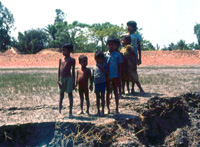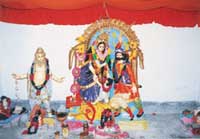During post-independence period, this region witnessed sudden influx of population mainly due to migration. The displaced persons forcibly occupied vested lands and cleared forests for habitation. Several such colonies sprung up in this manner. It exerted negative impact on the economy of fringe population. In Sundarban, 36.5% of the population belongs to SC/ST as compared to the State average of 25.61%. Nearly 95% of the population primarily depend on agriculture, which is mostly rain-fed mono-cropping, and about fifty percent of agriculturists are landless laborers. During agricultural lean season, people resort to fishing and collection of prawn seeds, even risking their lives from man-eating tigers and crocodiles. During April / May, some people also enter the Reserved Forests with permits, for collection of honey which is purchased back by West Bengal Forest Development Corporation Limited.
Backwardness of the region and almost complete dependence of the people on the natural resources of mangrove ecosystem can be attributed to the following factors:-
i) Uncontrolled population growth with low income level (Population increased from 1.2 million in 1951 to 3.9 million in 2001)
ii) Lack of major industries and large scale employment opportunities
iii) Lack of irrigation facility leading to rain-fed, mono-cropped agriculture
iv) Loss of productivity of potential cultivable land due to large scale expansion of aquaculture/ prawn farming
v) Lack of organized transport and communication facility
vi) Absence of Electricity supply in most of the islands
vii) Lack of medical facility, public health care and proper sanitary facilities viii)Occasional devastations by cyclonic storm.
In 4500 sq.km. inhabited areas, there is only 42 km. of railway line and about 300 km. of pucca road network. The only means of communication between the islands is through the waterways which is poorly organized and people have to depend on the private mechanized boats which are sometimes a serious life-risk. There is acute shortage of well-maintained jetties. Due to obvious reason of inaccessibility, much of the inhabited areas are yet to avail of the conventional electricity supply. Of late, there has been some perceptible breakthrough in the field of solar power supply to a few locations.













